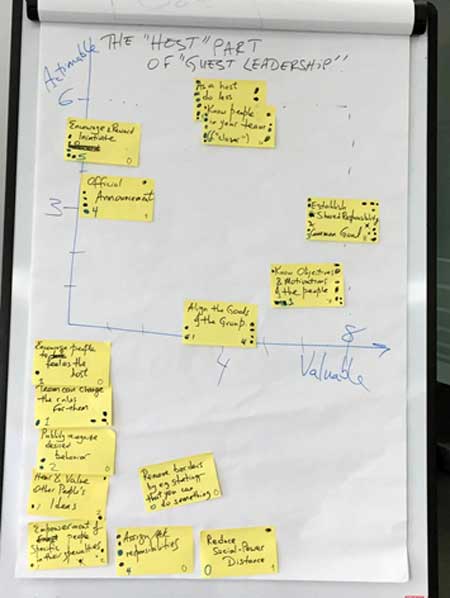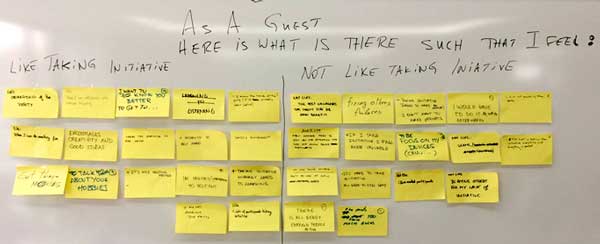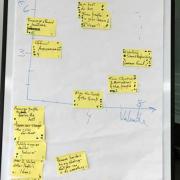CUTTER BUSINESS TECHNOLOGY JOURNAL VOL. 30, NO. 1
We usually think of leaders in large terms: Nelson Mandela, Martin Luther King Jr., Steve Jobs, and so on. However, small acts of leadership happen every day, forming the glue that holds civil society together. These include helping a shorter person put a bag in the overhead compartment, organizing neighborhood cleanups, or starting petitions to change government. These are moments of “guest leadership.”
Guest Leadership at a Filming
No one was in control at the filming of this musician’s music video, certainly not the musician. He had a vague idea of what he was after but, not being an organizer, was not set to coordinate the movements of the dozen or so of his friends and their friends who had come to be supportive and have a cameo in his video.
At some moment, someone said that a section of wall should be draped. One person went and found a curtain rod and a curtain, but the guest leader of the moment was the person who found a ladder and then coordinated a few other people to hang the curtain high enough to make the semblance of a wall. None of the people knew each other, nor was the musician present to oversee the effort. He was not even aware of what was being done; he only saw that the wall had been draped, per his (unstated) desire.
This activity of sporadic leadership by various people present continued for an hour or so. Some guests organized others, some were arms and legs for those with ideas, and some just sat and watched.
Finally satisfied, the musician shot the video, not having any idea of who had contributed what. All of the leaders and helpers were simply guests in his final video.
Guest leadership is rarer in work environments than in daily communities. In workplaces, employees typically wait to be told what to do, then consider how their actions will affect their annual work review and pay raise. Spontaneous moments of leadership do happen, but the usual corporate environments are not so conducive to it.
The Agile software revolution legitimized decentralized decision making with its call for self-organization. Decentralized decision making is useful in complex environments, such as those found in modern software development. In these environments, there is not enough time to funnel all the necessary information to a central point of control and wait for a decision. Quite the opposite: often the people closest to the situation have the experience and information needed to resolve the problem more quickly themselves.
An increasing number of work environments have the same characteristic of complex flows of information that require quick decisions and rapid actions. In addition, the rising demographic of millennials is increasingly allergic to centralized power and bosses telling them what to do. They also are looking for ways to decentralize decision making.
Organizations that are able to create a culture of guest leadership multiply the efforts of their staff. The question is, how does any person — whether in a power position or not — increase other people’s inclination to step forward into acts of guest leadership?
Leadership Stances
Some leaders are charismatic. They create a following. Others spend their energy evolving the environment around their people. Typically, we refer to the first type as “leaders,” and the second type as “managers.” They are both leaders, in different ways, taking different stances for different purposes. The former sets the direction so that people feel inclined to pursue it. The latter sets the environment so that people’s actions are effective.
Mark McKergow and Helen Bailey introduced the term “host leader” for the second kind of leader. Think of a party — perhaps a formal dinner party, perhaps a potluck dinner party, or a masquerade or pool party. The organizer is responsible for creating the mood and the legitimate action set of the attendees (beginning with the party invitation) and then for seeing to it that everyone is having a good time during the party.
In this article, I will refer to four different types of leadership: Leader 0 through Leader 3. Leader 0 is a solo leader with no followers (whom I still refer to as a leader for reasons that will become clear); Leader 1 is our usual idea of a leader as direction setter; Leader 2 is the leader as host; and Leader 3 is the guest as leader. Let us look at them in turn:
Leader 0: Solo Leader
Leader 0 demonstrates an individual but still important form of leadership. Although the solo leader does not enroll any followers, this person is still a leader because they step out from the crowd and take initiative. This person:
- Detects that an intervention is needed
- Decides “This is for me to take care of”
- Steps out of the crowd and takes some action
- Steps back into their previous position
The solo leader is the person who opens a window in a hot meeting room, who helps a shorter person reach a bag in the overhead bin, who picks up a dropped wallet and gives it back to the owner, who tells you your backpack is open.
Almost everyone acts as a solo leader at some time, even if they swear they never lead. Solo leaders are important to creating friendly spaces and a feeling of safety.
Leader 1: Leader as Direction Setter
Leader 1 is the type of leader we reflexively imagine when we hear the word “leader”: Gandhi, Mandela, Hitler, Kennedy, Martin Luther King Jr. Whether you agree with their platform or not, they were effective. What is it that this kind of a leader does that makes them effective? They:
- Attract attention
- Redirect that attention to somewhere
- Enroll others in finding that direction meaningful
We typically associate this type of leader with changing direction. When there is no change of direction to be made, the Leader 1’s work is to keep highlighting the importance of the current direction, to keep people from getting distracted and working toward any other direction. The work of this leadership stance is always direction.
Leader 2: Leader as Host
Leader 2 captures the stance described by McKergow and Bailey. This person:
- Creates a mood and an environment to support it
- Participates with the guests to see that they feel welcome, safe, included, and involved
- Steps in periodically to move the attention around, introduce people to each other, change the music, make announcements, and so on
- Steps away periodically to monitor the scene, to make judgments about what to change or not to change
Note that in the leader-as-host stance, there is no particular direction; the focus is on the creation of a quality of interaction. This person is still a leader, because they are taking initiative and responsibility for the mood and interactions.
Leader 3: Guest as Leader
Leader 3 is the guest leader, the subject of this article. This person is not an anointed or recognized leader in the situation. If at a party, they are not the host or a deputy of the host. If at work, they are not the boss or manager. Here are the things the guest leader does:
- Detects that an intervention is needed
- Decides “This is for me to take care of”
- Becomes Leader 0-2 for some period of time
- Steps back into their previous position
In a neighborhood, the guest leader is the person who decides to organize a block party or neighborhood potluck dinner or to clean up the neighborhood. At work, the guest leader is the person who argues for a change in office furniture to improve collaboration, starts a monthly social event, or motivates coworkers to try a new technique.
Moving Between Stances
It is common for people to move between stances in a situation. Here is a small example:
Guest Leadership, Moving Between Stances
It was about 2 am in Buenos Aires, and the streets were deserted. A friend and I were crossing a very large one-way street. A car turned into this very large, usually very busy one-way street going the wrong way. (Guest)
I decide to intervene. (Leader 3: Guest as Leader)
I jumped into the road to warn the driver that he was about to head up a very large one-way road the wrong way. (Leader 0: Solo Leader)
My Spanish was not good enough to get him to understand quickly what was happening. (He just saw someone strange jump into the road and shout bad Spanish at him.) I asked my friend to talk to him and explain what was up. She did so, becoming an enrolled follower. (Leader 1: Leader as Direction Setter)
I stepped back and watched the environment, looking for oncoming cars in either direction, and to check that my friend was being successful with her explanation. (Leader 2: Leader as Host)
The driver turned around. We resumed walking. (Guest)
Two interesting questions are:
- What enhances or diminishes people’s inclination to take the crucial step to intervene?
- Is there anything that can be done, either by a boss or established leader or by simply anyone, to increase people’s inclination to take that crucial step?
To pursue these questions, let us first look at collaboration, the preamble to guest leadership.
Collaboration Can Be Influenced
In the August 2007 issue of Cutter IT Journal, I wrote about my research on actions that improve collaboration. The punchline of that research is this: collaboration requires that a person step forward out of a crowd, attract attention to him- or herself, offer an idea or contribution, and step back into the crowd. This is very similar to what guest leadership demands. Everyone in the group can enhance the inclination to step forward by taking action in one of four ways:
1. Lift Others
Many people feel too modest about themselves and their ideas to speak up. You can help by raising their relative self-esteem and social rank:
- Recognize others.
- Lower your relative social position.
- Inquire, don’t contradict.
- Challenge, but adopt.
2. Increase Safety
Attracting attention and stepping forward is scary to most people. Offering an idea is potentially embarrassing, because it may be rejected. Therefore, the first thing to do is to create an environment where people feel safe to offer their ideas:
- Be yourself.
- Show you won’t hurt others.
- Add humor.
- Say something honest, on the edge of what you think is allowed.
3. Get Results
Results are what matter in collaboration; plus, getting results actually improves collaboration. So:
- Get back from diversions.
- Clarify the way forward.
- Say something valuable.
- Get one result.
4. Add Energy
Finally, the energy in the room matters to the inclination to collaborate. So:
- Keep your own energy high.
- Contribute.
- Challenge (to raise the energy).
In the 10 years since writing that article, I have seen how effective these actions are for raising — and their converse is for lowering — the inclination within a group to collaborate. Anyone in the group doing these actions helps get people into a state to collaborate, but when anyone in the group does the opposite of these actions, we can immediately see the people in the group retreat from collaboration.
If we are interested in enhancing people’s inclination to step forward and lead, then clearly all of these are things we need to take care of. Having them in hand, what else can we learn about getting guests to act as leaders?
Exploring Guest Leadership
Over the last year, I have been running workshops to learn what people find enhances and detracts from their inclination to step forward into a leadership moment. This includes both work and private environments. The questions I have asked are:
- As a guest, what is there in the moment such that I do/don’t feel inclined to step forward?
- What can a host do to increase my inclination to be a guest leader for a moment?
- What can a boss do to enhance the group’s inclination to act in guest leadership moments?
- What can anyone do to enhance this inclination?
The photos in Figures 1 and 2 show the work in two of the workshops.

Figure 1 — What can a host do?

Figure 2 — What enhances/detracts from my inclination to step forward as a guest leader?
What Enhances the Inclination to Step Forward?
In the workshops, two responses kept coming forward:
- Empathy
- Seeing that I can succeed
More intriguing was that, in some cases, a factor was named that both enhanced and dampened the inclination to step forward. In particular, seeing others step forward was one such factor:
Seeing others step forward shows me that it is OK to step forward and take a leadership moment
But at the same time:
If I see others stepping forward, I can relax, because they don’t need me; they will take care of it.
A number of people commented that if they see the host start to slice the bread or cheese and then get pulled away, they know it is OK to step in and complete the assignment. This gives us an idea of one way to trigger people to step forward: start something, then go away and leave it unfinished.
Several people highlighted the importance of the invitation to the party or the environment in general:
If I am invited to a formal dinner party, not only will I not offer to pour the wine or otherwise help, I understand that it might be an insult for me to try.
And:
In a potluck dinner party, we are all asked to bring things and to contribute. I know when I get there that I should watch and see if anything needs attention.
Here are some of the other key factors named for enhancing guest leadership moments:
- I can have an impact.
- It is in my personality.
- I have already had much experience with stepping forward like this.
- I want the result.
- I feel an urgency (as, in particular, if I see a child about to get hurt in a public place).
- Stepping forward is in my own self-interest.
- The environment is supportive.
- I have the skills and capacity to do it.
- I feel invested in the outcome.
- I feel there is nothing to lose and more to gain.
- There is an absence of other leadership.
- It resonates with my values.
- I know the host of the party.
- I feel more valuable.
Here are some of the key factors that diminish the inclination to step forward:
- I would get stuck doing it all the time.
- It means additional workload.
- There are already enough others stepping forward.
- The environment is toxic.
- I don’t actually like the other people there.
- I feel lazy.
- I fear failure.
- I don’t want to stand out.
- I fear I will be held accountable (e.g., the child hurt in a public place).
- I expect the usual suspects to step forward.
- I have self-doubt.
- I was educated to be passive.
- I like the status quo.
Improving the Culture Toward Guest Leadership
Much harder than working out why people step forward is asking whether it is possible to build a culture in which people take the guest leadership position more often and more naturally.
I was lucky enough to interview people at three companies where guest leadership is the norm, where everyone steps in at any time, no matter how junior they are. I asked the founder of one of the smaller companies what he had done, and he said:
I just made sure I wasn’t there more of the time.
His company was small, so all the employees simply had to make decisions and tell him what they had done afterward — which, of course, he was smart enough to agree with.
Another said:
I just said “yes” to everything they asked for.
A coach at one of the companies said:
We had a brand-new person, just out of university. The first time, he wouldn’t choose anything to do, because he didn’t know anything. So I asked him to choose a person to team with. The second time I asked him to choose something on his own. Now I don’t have to ask him anything; he is running around taking on anything he sees.
In the workshops, two things became clear:
- It is essential to reduce the sense of vertical (social) distance between senior and junior people, between people at different levels of the management or social hierarchy — that is, to make a “horizontal” social-professional culture.
- While there are some things anyone can do, there are some things that only the host or boss can do.
Our workshop participants found two activities that help reduce the sense of vertical distance. Both are to be done across social hierarchy levels:
- Cook and eat together. This is not the classic American 4th of July barbecue ceremony in which the bosses serve hamburgers to the line employees. This is really preparing food together, everyone helping everyone, with no job titles on display, and then sharing the results in a pleasant lunchtime or evening meal.
- “Dodgewalk” across management levels. “Dodgewalking” is a game introduced to me by Diego Fontdevila at Grupo Esfera, a Buenos Aires–based software and systems architecture development firm. Participants form two lines facing each other. The people in one line stand still. The other line walks toward them. At some “last instant,” the walking people have to jump or step to the side to avoid the people standing still. Run the game half a dozen times or so, taking turns as to which side stands still and which walks/jumps. Since the people take turns having to stand passively and having to decide when to step aside, it is a fun game that shifts power and social status.
For things that anyone can do, the top suggestions were:
- Ask your trusted friends and colleagues to model stepping forward into guest leadership, to set the tone in the community.
- Start telling approving stories of times when you see guest leadership being assumed — anywhere, but especially in your community.
- Discuss together, perhaps in reflection workshops or retrospectives, what have been good opportunities for guest leadership in the recent past.
For bosses and hosts:
- Do less.
- Make it clear when inviting people to a get-together, or when hiring them and introducing them to the department, that guest leadership and initiative taking are welcome, even the norm.
- Set up a Big Brother/Big Sister type of system for new employees, pairing them with more senior people who can show the guest leadership habits, so the newcomers pick up those habits right away.
- Just say “yes” to people’s requests. Periodically discuss them with your employees in order to set a common understanding of which sorts of initiative taking are in keeping with the direction you are after.
- Keep teams well mixed in terms of gender, age, culture, specialty, and personality (“neurodiversity”).
To Sum Up
Guest leadership is a remarkably commonplace phenomenon once you start to notice it. It is less common in workplaces than in daily communities, one of the reasons being the sense of hierarchical or vertical social distance in the workplace. To enhance guest leadership in the work environment, the first thing to do is to make experimentation safe and to reduce the sense of vertical distance.
The top motivators given for people to step forward and lead are:
- Empathy for the people being helped
- Caring about the result
- Seeing others step forward
- Knowing I won’t get punished for trying
- Believing I can succeed with the intervention
The demotivators are:
- Fear of reprisal
- The feeling that enough others are already stepping forward
- Fear of failure
- Not wanting to stand out
Bosses and hosts can assist in creating a culture of guest leadership by:
- Being absent and later approving the decisions others take
- Just saying “yes” to ideas
- Telling stories of good guest leadership to set a culture in motion
Anyone can increase the inclination to lead through:
- Use of the collaboration actions
- Asking friends to contribute moments of guest leadership, thereby modeling and creating a culture of guest leadership.
- Discussing the topic at retrospectives
A Final Example
One of the students in my class told us this story after having spent a day discussing collaboration and guest leadership:
Brandon was invited as a consultant to attend an executive meeting about introducing Agile to a company. The vice CEO was present as the meeting’s sponsor. There was an official facilitator for the meeting whose aggressive agenda was to get through the entire sequence of vision, mission, key objectives, and action items in only 90 minutes. In this situation, Brandon was a guest, uncertain what his contribution would be.
As the meeting unfolded, Brandon watched the use and violation of the collaboration actions. He selected a few actions he could take among the participants, without interfering with either the facilitator or the vice CEO. He started with “Get back from distractions,” “Clarify the way forward,” and “Say something valuable” as the ones that would contribute the most to completing the agenda with the least imposition on the others present.
The group rather remarkably managed to get through the entire sequence in time. At the end, the vice CEO turned to Brandon and said, “And you’re on this full time.” Evidently, his moments of guest leadership, while minor, did not go unnoticed.



